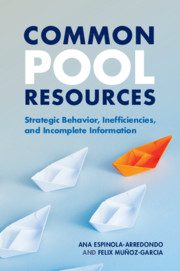Book contents
- Frontmatter
- Contents
- List of Figures
- List of Matrices
- Preface
- 1 Introduction
- 2 Common Pool Resources in a Static Setting
- 3 Common Pool Resources in a Dynamic Setting
- 4 Entry Deterrence in the Commons
- 5 Repeated Interaction in the Commons
- 6 Commons under Incomplete Information
- 7 Signaling in the Commons
- Appendix A Game Theory Tools
- Appendix B Solutions to Selected End-of-Chapter Exercises
- Bibliography
- Index
Appendix B - Solutions to Selected End-of-Chapter Exercises
Published online by Cambridge University Press: 03 August 2023
- Frontmatter
- Contents
- List of Figures
- List of Matrices
- Preface
- 1 Introduction
- 2 Common Pool Resources in a Static Setting
- 3 Common Pool Resources in a Dynamic Setting
- 4 Entry Deterrence in the Commons
- 5 Repeated Interaction in the Commons
- 6 Commons under Incomplete Information
- 7 Signaling in the Commons
- Appendix A Game Theory Tools
- Appendix B Solutions to Selected End-of-Chapter Exercises
- Bibliography
- Index
Summary
CHAPTER 2 – COMMON POOL EESOURCES IN A STATIC SETTING
Exercise 2.1 – Allowing for Different Cost Externalities
Consider the setting in Section 2.3 and, for simplicity, assume N = 2 firms. In addition, consider that every firm's cost function is
where θ≥ 0 denotes the severity of the cost externality. When θ= 0, firm i 's costs are unaffected by its rival's appropriation qj , whereas when θ >0, firm i 's costs are affected by qj . As a remark, note that our setting in Section 2.3 can be interpreted as a special case of this more general model, where θ= 1.
(a) Find every firm i 's best response function, qi(qj) .
• Each firm chooses its appropriation level qito solve
Following Section 2.3, we normalize the price of the good to $1. Differentiating with respect to qi , we obtain
To find the best response function, we first rearrange the equation to S = 2qi+ θqj , and solving for qiwe find
This indicates that appropriation levels are strategic substitutes, that is, an increase in firm j 's appropriation induces a reduction in firm i ’s.
(b) How is qi(qj)affected by an increase in parameter θ ? Interpret.
• Differentiating qi(qj)with respect to θ , we obtain that
Therefore, when firm jappropriates one more unit, it affects firm i 's cost more significantly as the severity of the cost externality, θ , increases. This intuition goes in line with our interpretation in part (a).
(c) Find the equilibrium appropriation q *i.
• In a symmetric equilibrium, appropriation levels satisfy qi= qj= q *i.
Therefore, as the stock becomes more abundant (higher S), equilibrium appropriation increases.
(d) How is q *iaffected by an increase in parameter θ ? Interpret.
• An increase in θdecreases the equilibrium appropriation. We can find the exact amount by which it decreases by taking a derivative:
A higher θincreases the negative externality from the other firm's exploitation of the resource, which increases the marginal cost for firm i . The increase in marginal cost (absent a change in the price, or marginal revenue, of the good) reduces the equilibrium appropriation from the firm.
Information
- Type
- Chapter
- Information
- Common Pool ResourcesStrategic Behavior, Inefficiencies, and Incomplete Information, pp. 130 - 198Publisher: Cambridge University PressPrint publication year: 2021
